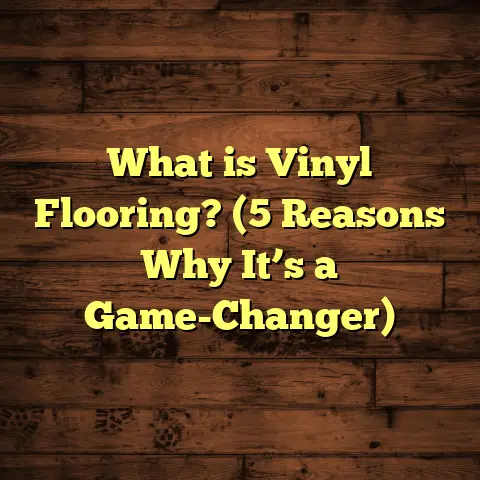What is a Floor Plug? (5 Essential Uses and Benefits Revealed)
Waterproof flooring options have become a game-changer for many homeowners, especially those who want durability and style without worrying about water damage. I’ve worked with various waterproof materials—from vinyl to treated hardwood—and one thing I often come across is the need for clean, professional finishes where electrical or cable outlets meet the floor surface. That’s where floor plugs come in handy.
Now, you might be wondering, what exactly is a floor plug? Let me break it down for you.
What Is a Floor Plug?
A floor plug is a type of cover or insert used to close off openings in floors, mainly to protect electrical, data, or other utility outlets embedded in the flooring. These plugs are designed to sit flush with the floor surface, ensuring safety and aesthetics.
Think of floor plugs as small, sturdy caps that fill the holes or cutouts made during installation for wiring or piping access. They prevent debris accumulation and water seepage while providing a neat appearance.
Typically, floor plugs come in various sizes—most commonly 2 to 4 inches (50 to 100 mm) in diameter—but can be custom-made for specific needs. The materials range from plastic and rubber to metal, depending on the environment and expected wear.
I remember one project where we installed waterproof vinyl flooring in a kitchen renovation. The client wanted several power outlets installed directly into the floor for countertop appliances. We used brass floor plugs with rubber seals around them to prevent any water from getting into the electrical boxes beneath the floor. It was a small detail but made a huge difference in function and peace of mind.
How Much Do Floor Plugs Cost?
Prices vary widely based on material and design. Basic plastic plugs can cost as little as $5 each, while high-quality brass or stainless steel plugs with waterproof seals can run up to $50 or more per piece.
Installation usually takes about 30 minutes per plug, assuming the outlet box is already installed beneath the floor. Labor can cost between $40 to $80 per hour depending on your local rates.
Because these plugs protect expensive wiring and prevent damage from moisture, their cost is generally well worth it.
A Brief History of Floor Plugs
You might not realize it, but floor plugs have a surprisingly long history tied to how buildings have evolved.
Back in the early 1900s, most homes had electrical wiring running through walls and ceilings. But as technology advanced by mid-century—especially with the rise of office buildings and open-plan layouts—power needed to be accessible in more places. This led to outlets installed into floors for convenience.
Initially, these openings were just left exposed or covered with simple lids that weren’t water-resistant or durable. Over time, with increasing awareness of safety and aesthetics, manufacturers began designing specialized floor plugs to protect these openings while integrating visually with different flooring materials.
Today’s floor plugs incorporate modern materials and engineering to provide waterproofing, durability against foot traffic, and customizable appearances.
Types of Floor Plugs
There’s no one-size-fits-all when it comes to floor plugs. Depending on your flooring type, location of use, and environmental conditions, you’ll find several options:
1. Plastic Floor Plugs
These are the most affordable and widely used plugs for residential applications. Made from polypropylene or PVC plastic, they’re lightweight and easy to install.
They work well in dry indoor areas but aren’t ideal for wet areas because plastics can degrade or let moisture seep through over time.
2. Rubber Floor Plugs
Rubber plugs provide better sealing against moisture due to their flexibility and compressibility. They’re often used in wet rooms like bathrooms or kitchens where some water exposure is expected.
Their downside? They may wear out faster under heavy foot traffic or sharp impacts.
3. Metal Floor Plugs
Brass, stainless steel, or aluminum plugs offer excellent durability and resistance to wear. They’re common in commercial spaces like offices or retail stores where foot traffic is heavy.
Metals can be finished with brushed or polished looks matching surrounding floor materials like wood or tile.
4. Wooden Floor Plugs
These are custom-made plugs designed to blend perfectly with hardwood floors. They can be stained or varnished to match individual planks.
Wooden plugs are aesthetically pleasing but less suitable for wet areas unless specially sealed.
5. Composite Floor Plugs
Newer composite plugs combine materials like fiberglass-reinforced plastics with rubber seals for waterproofing and strength.
They’re rising in popularity because they balance durability with moisture resistance at moderate costs.
Materials Matter: Choosing What Fits Your Needs
When I recommend floor plugs to clients, I always start by asking about their flooring type and room conditions. For example:
- If you have waterproof vinyl, plastic or rubber plugs with good sealing are enough.
- For hardwood floors in living rooms or offices, metal or wooden plugs create seamless aesthetics.
- In high-moisture commercial kitchens, metal plugs with silicone gaskets provide maximum protection.
- For outdoor decks, UV-resistant composite plugs prevent fading and cracking from sun exposure.
Each material has its pros and cons related to durability, waterproofing ability, cost, and visual appeal.
Installation Process: What Happens Underneath?
Floor plug installation isn’t just about snapping something onto the floor surface. Here’s how it typically goes:
- Planning & Measuring: Accurate measurement of outlet box diameter and depth is critical. For instance, a standard electrical box may require a plug that’s 3 inches (76 mm) wide and fits flush within a 1-inch (25 mm) depth cutout.
- Cutting the Floor: Using specialized hole saws or routers tailored to your flooring material (e.g., diamond blades for tile), we create precise openings without damaging surrounding areas.
- Fitting the Outlet Box: The electrical or data outlet box is secured beneath the cutout if not already installed.
- Sealing: Waterproofing membranes or sealants are applied around edges for water-prone areas.
- Plug Installation: The floor plug is inserted—sometimes screwed in place or snapped firmly—to ensure no movement occurs under foot traffic.
- Testing: For waterproofed areas, we often do a water test by pouring a small amount near the plug and checking for leaks after 24 hours.
In my experience working on a multi-family apartment project recently, attention to these installation steps saved the building owner thousands in potential repairs by avoiding water damage around floor outlets.
Maintenance: Keeping Floor Plugs Working Long-Term
Once installed properly, floor plugs don’t usually need much maintenance beyond regular cleaning. However:
- Check seals annually for cracking or wear—rubber gaskets tend to degrade after about 5 years.
- Tighten screws if you feel any looseness; loose plugs can trap dirt or become tripping hazards.
- Replace damaged or faded plugs promptly—especially if they lose waterproof integrity.
- Clean around plugs gently with non-abrasive cleaners; avoid harsh chemicals that might degrade materials.
I once had a client call me because their kitchen floor outlet plug was sticky and smelled musty after a couple of years. Turns out water had seeped through a damaged rubber seal that wasn’t replaced on time. Replacing the plug and resealing fixed everything immediately.
Troubleshooting Common Issues With Floor Plugs
Floor plugs are simple but do occasionally have problems:
Problem: Plug Won’t Stay Secure
If your plug pops out when stepped on or doesn’t fit tightly:
- The opening might be too large.
- The plug size might not match the outlet box diameter.
- Screws or locking mechanisms might be missing or stripped.
Solution: Measure again carefully; use correct-sized plugs; install locking screws if available.
Problem: Water Leakage
If you notice dampness under waterproof floors near outlets:
- Seals may be worn or missing.
- Installation may have gaps around edges.
- The plug material may not be suitable for wet environments.
Solution: Replace seals; apply waterproof caulking; use metal or composite plugs with proven waterproof ratings.
Problem: Plug Surface Damage
Scratches, dents, or discoloration happen especially in high-traffic zones:
- Plastic plugs scratch easily.
- Metal plugs can dent but resist scratches better.
- Wooden plugs may chip if exposed to moisture or impact.
Solution: Consider upgrading to tougher materials; apply surface treatments like sealers; replace damaged plugs promptly.
Cost Breakdown: What You Can Expect to Pay
Costs vary depending on plug material, size, quantity, installation complexity, and location.
| Material | Plug Cost Per Unit | Installation Time (per plug) | Labor Rate (per hour) | Total Cost Estimate (including labor) |
|---|---|---|---|---|
| Plastic | $5 – $10 | 0.5 hours | $40 – $80 | $25 – $50 |
| Rubber | $10 – $20 | 0.5 hours | $40 – $80 | $30 – $60 |
| Metal (Stainless) | $25 – $50 | 0.75 hours | $40 – $80 | $55 – $110 |
| Wooden (custom) | $30 – $45 | 1 hour | $40 – $80 | $70 – $125 |
| Composite | $20 – $40 | 0.75 hours | $40 – $80 | $50 – $95 |
For typical home installations with about 10 floor plugs, expect total costs ranging from $250 (basic plastic) up to $1,000+ (high-end metal or custom wooden).
Comparing Floor Plugs With Other Floor Outlet Covers
You may ask: Why choose floor plugs over other options like flip covers or pop-up outlets?
Floor Plugs vs Flip Covers
Flip covers open upwards revealing sockets but can be bulky and sometimes catch debris along hinges. They’re less likely to be waterproof unless specifically designed for it.
Floor plugs provide a completely flush surface with no moving parts exposed—better for wet or high-traffic areas.
Floor Plugs vs Pop-Up Outlets
Pop-up outlets offer convenience for occasional use but involve mechanical parts that may fail over time and usually cost more upfront ($100+ each).
Floor plugs are simpler and more durable but less convenient if you need frequent access to power underfoot.
For residential settings with occasional outlet use in floors (like living rooms), pop-up units may be preferred. But for permanent installations needing protection from water and traffic (kitchens, offices), floor plugs win hands down.
Insights From Personal Projects
Over my years contracting flooring projects spanning homes, offices, restaurants, and daycare centers, I’ve noticed some trends:
- Clients choosing waterproof vinyl floors almost always need rubber-sealed floor plugs.
- Hardwood floors look best with wooden-inlay plugs stained to match perfectly.
- Commercial spaces prioritize metal plugs for durability despite higher costs.
- When installing floor outlets outdoors on decks or patios, UV-resistant composite plugs prevent fading better than wood or plastic.
- Adding just one well-sealed floor plug can save thousands down the road by preventing water damage in sensitive electrical systems.
One favorite project was an upscale cafe renovation where we installed terrazzo floors embedded with power outlets for baristas’ equipment. We used custom brass floor plugs with silicone gaskets that blended beautifully with terrazzo colors while guarding against frequent spills behind the counter. The owner was thrilled because it kept the space safe without compromising design style.
How To Choose The Right Floor Plug For Your Project
Here’s a quick checklist I give clients when selecting floor plugs:
- What kind of flooring do you have? (vinyl/wood/tile)
- Is the area prone to moisture? (bathroom/kitchen/outdoor)
- What level of foot traffic will it see? (light/residential vs heavy/commercial)
- Do you want the plug color/material to match flooring exactly?
- How often do you need access to this outlet?
- What’s your budget per plug including installation?
Answering these helps narrow down choices quickly rather than guessing from dozens of models online.
Future Trends In Floor Plug Designs
Flooring technology keeps evolving just like other building components. Here are some innovations I’m keeping an eye on:
- Smart Floor Plugs: Integrated sensors that detect moisture intrusion under floors and send alerts before damage occurs.
- Modular Plug Systems: Interchangeable covers that snap into standardized bases allowing quick swaps between power/data modules.
- Eco-friendly Materials: Biodegradable composites replacing plastics for greener construction.
- Improved Waterproofing Tech: New polymer seals lasting decades instead of years even under heavy chemical exposure.
I recently spoke with a manufacturer developing floor plugs that double as wireless charging pads embedded into hardwood floors—combining aesthetics and tech seamlessly!
Summary of Benefits at a Glance
Floor plugs help you:
- Keep floors clean by sealing off openings
- Protect electrical/data outlets from moisture damage
- Enhance safety by covering hazardous holes
- Create seamless visual finishes matching your flooring
- Allow easy future access without damaging floors
- Reduce maintenance costs over time
- Meet building codes requiring outlet protection
FAQs About Floor Plugs
Q: Can I install floor plugs myself?
If you are handy and have tools like hole saws matched to your flooring type, yes—but be careful cutting precise holes without damaging floors. For most people, hiring a pro saves headaches and ensures waterproof sealing is done correctly.
Q: How often should seals on rubber floor plugs be replaced?
Typically every 3–5 years depending on use and exposure to moisture/chemicals.
Q: Are there fire-resistant floor plugs?
Yes—metal plugs like brass or stainless steel offer better fire resistance than plastic/rubber variants.
Q: Can floor plugs support heavy furniture?
Most metal or composite plugs are designed to withstand typical residential/commercial foot traffic plus furniture weight without damage if installed correctly.
If you’re planning a renovation involving embedded power outlets in your floors—or simply want safer floors with better utility—floor plugs are worth serious consideration.
Have questions about specific materials? Need installation advice? Just ask—I’m always happy to help!





